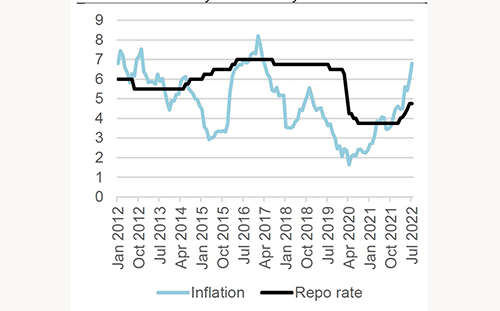Indebted Namibian households and corporates can continue to expect a tight financial environment for the foreseeable future as interest rate hikes are expected to rise further towards the end of this year and during the first half of 2023.
“We expect rising interest rates, coupled with high rates of inflation to weigh on consumer spending, a key driver for our economy. However, early estimates indicate that central banks could be cutting policy interest rates as soon as the second half of 2023. So, there might be some respite for consumers in the near future,” reads an analysis by Simonis Storm.
The local stock brokerage noted the Bank of Namibia’s Monetary Policy Committee (MPC) conducted their fourth meeting for 2022, in the midst of heightened probabilities of economic recessions in advanced economies, and threats of new geopolitical tensions between China and Taiwan and signs of global deflationary pressures. Last week, the MPC confirmed an increase in the repo rate by 75bps, from 4.75% to 5.50%.
SS further pointed out that some 70 central banks across the globe hiked their policy rates by 50bps or more in a single meeting this year. Namibia joined this group of global central banks, having hiked by 50bps in June 2022, which was the largest single hike for the central bank in the last 10 years.
The latest repo rate increase follows the South African Reserve Bank’s (SARB’s) decision to hike by 75bps in their July meeting.
“At the start of August, the Forward Rate Agreement (FRA) curve factors in about another 100bps hike in South Africa before the end of this year, which would take South Africa’s repo rate from 5.50% to 6.50%. If this materialises, we see similar movements in Namibia taking place, which implies a prime interest rate of 10.25% in Namibia possibly by the end of the year,” SS cautioned.
Furthermore, BoN expects foreign currency reserves to decrease by N$4 billion before the end of the year, from about N$42 billion to N$38 billion. This is mainly due to the rising import bill, which is being driven higher primarily from fuel imports and this will draw down on foreign currency reserves.
It is in this vein that SS believes is likely to follow interest rate decisions emanating out of South Africa for the rest of 2022.
Meanwhile, the SS report states the repo rate remains low relative to inflation in Namibia and South Africa, suggesting that monetary policy is accommodative at the moment.
“The repo rate has never been so low compared to inflation in the last 10 years, both in Namibia and South Africa. However, the gap is narrowing as the pace of hikes gain momentum,” the report reads, indicating that policy might be deemed restrictive in the near future.
According to ETM Analytics, African central banks have been quite aggressive in their key policy interest rate hikes during 2022 as inflationary pressures persist. This is as a number of African central banks have hiked their policy rates in 2022.
Global inflationary pressures originate from elevated oil prices, supply chain pressures, high food prices that have been exacerbated by droughts, floods and insect infestations in some countries, as well as elevated commodity prices to broad-based currency weakness.
“Indeed, currency weakness has been one of the factors leading to interest rate hikes as inflation is primarily driven by supply side factors. Increasing rates to improve carry trade returns (which are affected by interest rate differentials between countries) and limit Rand weakness has been frequently cited by ourselves as a mechanism to indirectly contain inflation,” SS stated.


